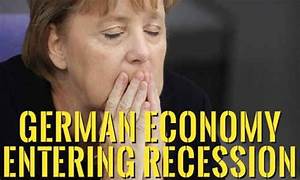Digital Zeitgeist – German Economy Slips into Recession as High Prices Take Toll – Revised Figures Reveal Impact on Consumer Spending and Growth Prospects
Introduction:
The German economy has recently received a sobering blow as revised figures confirm that the country has fallen into a recession. The impact of high prices on the economy has proven to be more substantial than initially estimated. Updated data released by Germany’s federal statistical office reveals a 0.3% contraction in gross domestic product (GDP) during the first quarter compared to the previous three months. These revised numbers confirm a consecutive two-quarter decline, meeting the technical definition of a recession. This article will delve into the factors contributing to this economic downturn, highlighting the repercussions of higher prices on consumer spending and providing expert insights on the road ahead.
High Prices and Consumer Spending:
The persistence of high price increases has taken a toll on the German economy, particularly evident in consumer spending patterns. The statistics office highlights that household spending dropped by 1.2% in the first quarter. This decline stems from households being forced to tighten their budgets, reducing food, clothing, and furniture expenditures. The impact extends beyond individual households, as government spending also dipped by 4.9% compared to the previous quarter. As a result, Germany’s overall GDP experienced a contraction, reflecting the economic strains induced by inflated prices.
Carsten Brzeski, the global head of macro at the Dutch bank ING, emphasizes the gravity of the situation, stating, “It took a couple of statistical revisions, but at the end of the day, the German economy actually did this winter what we had feared already since last summer: it fell into a technical recession.” These words underscore the significance of addressing the underlying issues that contribute to the decline in purchasing power and hinder economic growth.
Broader Economic Challenges:
Beyond the immediate impact of high prices, other challenges loom over the German economy. Brzeski warns that weaker industrial sector orders, rising interest rates, and a slowdown in foreign economic growth, particularly in the United States, will likely lead to a further weakening of economic activity in the months ahead. The ongoing war in Ukraine, demographic changes, and the current energy transition are also expected to exert structural pressures on the German economy in the coming years. While the drop in GDP does not represent the worst-case scenario of a severe recession, it does indicate a concerning decline of almost 1% since last summer.
Potential Factors for Recovery:
Despite the challenging economic landscape, there are some glimmers of hope for Germany’s recovery. The warm winter weather and the rebound in industrial activity, aided by the reopening of the Chinese market and easing of supply chain frictions, provided some relief. However, these factors were ultimately insufficient to propel the economy out of the recessionary danger zone.
The Path Ahead:
As Germany confronts the challenges presented by the recession, policymakers, businesses, and consumers must collaborate to devise effective strategies for recovery. Addressing the issue of high prices and finding ways to alleviate the burden on households should be a priority. Furthermore, measures are essential to stimulate industrial sector growth, diversify economic activities, and enhance resilience to external shocks.
Conclusion:
As revealed by revised figures, the German economy’s descent into recession highlights the detrimental impact of high prices on economic performance. With the persistence of these price increases, consumer spending has contracted, amplifying the economic challenges faced by the country. While the drop in GDP falls short of a severe recession, it warrants attention and proactive measures. Germany must address cyclical factors and structural issues such as demographic changes and the ongoing energy transition. By tackling these challenges head-on and implementing strategic recovery measures, Germany can navigate its way back to a path of sustainable economic growth.
online sources: German Federal Statistical Office, Carsten Brzeski, Global Head
Disclaimer: The views and opinions expressed in this article are those of the author and do not necessarily reflect the official policy or position of GPM-Invest or any other organisations mentioned. The information provided is based on contemporary sourced digital content and does not constitute financial or investment advice. Readers are encouraged to conduct further research and analysis before making any investment decisions.

